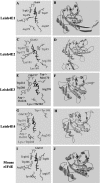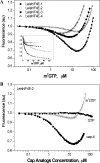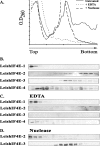Binding specificities and potential roles of isoforms of eukaryotic initiation factor 4E in Leishmania
- PMID: 17041189
- PMCID: PMC1694823
- DOI: 10.1128/EC.00230-06
Binding specificities and potential roles of isoforms of eukaryotic initiation factor 4E in Leishmania
Abstract
The 5' cap structure of trypanosomatid mRNAs, denoted cap 4, is a complex structure that contains unusual modifications on the first four nucleotides. We examined the four eukaryotic initiation factor 4E (eIF4E) homologues found in the Leishmania genome database. These proteins, denoted LeishIF4E-1 to LeishIF4E-4, are located in the cytoplasm. They show only a limited degree of sequence homology with known eIF4E isoforms and among themselves. However, computerized structure prediction suggests that the cap-binding pocket is conserved in each of the homologues, as confirmed by binding assays to m(7)GTP, cap 4, and its intermediates. LeishIF4E-1 and LeishIF4E-4 each bind m(7)GTP and cap 4 comparably well, and only these two proteins could interact with the mammalian eIF4E binding protein 4EBP1, though with different efficiencies. 4EBP1 is a translation repressor that competes with eIF4G for the same residues on eIF4E; thus, LeishIF4E-1 and LeishIF4E-4 are reasonable candidates for serving as translation factors. LeishIF4E-1 is more abundant in amastigotes and also contains a typical 3' untranslated region element that is found in amastigote-specific genes. LeishIF4E-2 bound mainly to cap 4 and comigrated with polysomal fractions on sucrose gradients. Since the consensus eIF4E is usually found in 48S complexes, LeishIF4E-2 could possibly be associated with the stabilization of trypanosomatid polysomes. LeishIF4E-3 bound mainly m(7)GTP, excluding its involvement in the translation of cap 4-protected mRNAs. It comigrates with 80S complexes which are resistant to micrococcal nuclease, but its function is yet unknown. None of the isoforms can functionally complement the Saccharomyces cerevisiae eIF4E, indicating that despite their structural conservation, they are considerably diverged.
Figures








Similar articles
-
Cap-binding activity of an eIF4E homolog from Leishmania.RNA. 2004 Nov;10(11):1764-75. doi: 10.1261/rna.7520404. Epub 2004 Sep 23. RNA. 2004. PMID: 15388875 Free PMC article.
-
Nutritional stress affects an atypical cap-binding protein in Leishmania.RNA Biol. 2012 Dec;9(12):1450-60. doi: 10.4161/rna.22709. Epub 2012 Nov 7. RNA Biol. 2012. PMID: 23135001
-
LeishIF4E-5 Is a Promastigote-Specific Cap-Binding Protein in Leishmania.Int J Mol Sci. 2021 Apr 12;22(8):3979. doi: 10.3390/ijms22083979. Int J Mol Sci. 2021. PMID: 33921489 Free PMC article.
-
Cap in hand: targeting eIF4E.Cell Cycle. 2009 Aug 15;8(16):2535-41. doi: 10.4161/cc.8.16.9301. Epub 2009 Aug 17. Cell Cycle. 2009. PMID: 19597330 Review.
-
eIF4E and Interactors from Unicellular Eukaryotes.Int J Mol Sci. 2020 Mar 21;21(6):2170. doi: 10.3390/ijms21062170. Int J Mol Sci. 2020. PMID: 32245232 Free PMC article. Review.
Cited by
-
The four trypanosomatid eIF4E homologues fall into two separate groups, with distinct features in primary sequence and biological properties.Mol Biochem Parasitol. 2011 Mar;176(1):25-36. doi: 10.1016/j.molbiopara.2010.11.011. Epub 2010 Nov 24. Mol Biochem Parasitol. 2011. PMID: 21111007 Free PMC article.
-
Regulation of Germ Cell mRNPs by eIF4E:4EIP Complexes: Multiple Mechanisms, One Goal.Front Cell Dev Biol. 2020 Jul 7;8:562. doi: 10.3389/fcell.2020.00562. eCollection 2020. Front Cell Dev Biol. 2020. PMID: 32733883 Free PMC article. Review.
-
Deletion of a Single LeishIF4E-3 Allele by the CRISPR-Cas9 System Alters Cell Morphology and Infectivity of Leishmania.mSphere. 2019 Sep 4;4(5):e00450-19. doi: 10.1128/mSphere.00450-19. mSphere. 2019. PMID: 31484740 Free PMC article.
-
Computational study on the allosteric mechanism of Leishmania major IF4E-1 by 4E-interacting protein-1: Unravelling the determinants of m7GTP cap recognition.Comput Struct Biotechnol J. 2021 Apr 5;19:2027-2044. doi: 10.1016/j.csbj.2021.03.036. eCollection 2021. Comput Struct Biotechnol J. 2021. PMID: 33995900 Free PMC article.
-
LeishIF4E1 Deletion Affects the Promastigote Proteome, Morphology, and Infectivity.mSphere. 2019 Nov 13;4(6):e00625-19. doi: 10.1128/mSphere.00625-19. mSphere. 2019. PMID: 31722993 Free PMC article.
References
-
- Altmann, M., I. Edery, H. Trachsel, and N. Sonenberg. 1988. Site-directed mutagenesis of the tryptophan residues in yeast eukaryotic initiation factor 4E. Effects on cap binding activity. J. Biol. Chem. 263:17229-17232. - PubMed
-
- Altmann, M., P. P. Muller, J. Pelletier, N. Sonenberg, and H. Trachsel. 1989. A mammalian translation initiation factor can substitute for its yeast homologue in vivo. J. Biol. Chem. 264:12145-12147. - PubMed
-
- Andersen, J., and G. W. Zieve. 1991. Assembly and intracellular transport of snRNP particles. Bioessays 13:57-64. - PubMed
Publication types
MeSH terms
Substances
LinkOut - more resources
Full Text Sources
Other Literature Sources
Molecular Biology Databases
Miscellaneous

